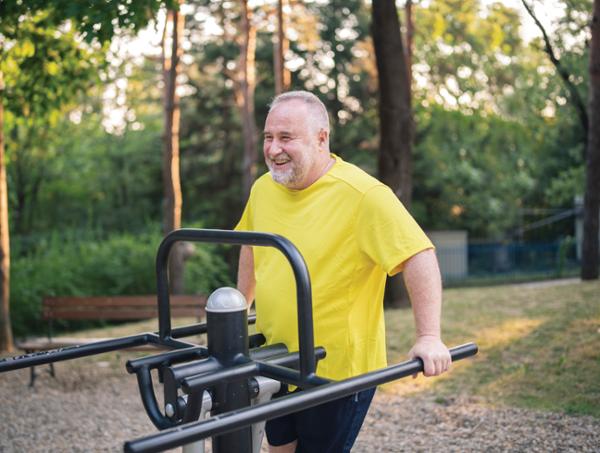features
Interview: Lou Atkinson
If operators want to grow their business, they need to support those with long-term health conditions, says Exi’s head of research. She tells Kate Cracknell how this can be achieved

Tell us about Exi
It’s a platform that supports professionals to prescribe and refer patients to exercise, as well as enabling people with long-term health conditions to safely increase their physical activity levels.
We’re an SaMD business (Software as a Medical Device) and part of the emerging field of digital therapeutics which is changing the way people access wellness expertise and interventions.
Exi is designed to support 23 comorbid physical and mental health conditions, such as obesity, cardiovascular disease, diabetes, hypertension, stroke, asthma, COPD, depression, anxiety, stress and so on.
What’s the set-up?
There are two main parts to the platform: a smartphone app for end users and a secure data portal for professionals – doctors, for example, or fitness professionals running an exercise referral programme or PT business.
The smartphone app works with or without a wearable, although we recommend using one if possible. Users input their personal information – including demographics, current physical activity level and any medical conditions – and the app uses this to create a safe, personalised physical activity prescription that incorporates the latest clinical evidence, as well as activity guidelines from the WHO, NICE and ACSM Exercise is Medicine (www.exerciseismedicine.org).
What makes it effective?
Crucially, Exi also incorporates behaviour change support, making it fun, engaging and interesting for users to keep going with their activity prescription. That includes extrinsic motivation with rewards, which can be financial should our partners wish and also intrinsic motivation. The key is keeping people engaged with the programme for long enough to feel the benefits, because that’s the basis for sustainable, health-enhancing behaviour change.
All the data in both the UK and US models of healthcare show that the ROI is there for these types of interventions in terms of reduced hospital admissions and reduced cost of medication.
Underpinning all of this is a huge amount of science and experience within our team gained from working with these populations, on top of which we continually explore the evolutions in digital technology to make our UX and UI more meaningful and motivating for end users and clinicians.
How does it connect exercise with the medical profession?
Our secure practitioner data portal is what really makes us a ‘healthcare’ system. This enables professionals overseeing programmes to track participants’ progress in real-time.
In turn, support can be tailored and resources maximised: a light touch of reinforcement and encouragement can be given to those who are progressing well, for example, with face-to-face appointments and phone calls reserved for those who need more support. This approach also helps ensure the right people get the right support at the right time.
It also encourages healthcare professionals – many of whom don’t feel confident in their own knowledge of physical activity – to bring the exercise conversation higher up the priority list.
With Exi, they know the exercise prescription will be done safely and will benefit their patients and with access to the data portal, they also know they can have informed conversations about it.
When they begin to see the results – more active patients also benefiting health-wise – it really helps reinforce the message that exercise is medicine.
How do the exercise prescriptions work?
Once users have input their personal information, Exi tells them how often and for how long they need to be active, as well as the intensity they need to achieve.
It then offers a choice of activities that will allow them to achieve that: it’s important to give people autonomy and choice as this drives adherence to the programmes. There are video and audio activities in the app that users can enjoy, but equally it might be a case of them going for a walk with a friend – it’s about them finding something they enjoy and want to do.
How do the programmes support progression?
We gradually progress each individual to get them to – or as close as possible to – the National Physical Activity Guidelines for healthy adults, meaning 150 minutes of moderate intensity activity a week or 75 minutes of vigorous activity. At the moment that happens over the first 12 weeks, but we’re moving away from this set timeframe because some people need longer.
The prescription is specifically tailored to the health needs and starting point of each individual, making it safe and achievable and even once they’ve reached the national guidelines – or their personal goal, if national guidelines aren’t achievable due to their health conditions – Exi motivates them to keep going while the new habits embed.
It can also be a tool for ongoing monitoring. For example, if a user’s diabetes is under control, they might only meet with the nurse twice a year to monitor their condition and the app allows for tracking and information exchange between appointments.
We’re about to start a two-year programme for Type 2 diabetics in collaboration with Milton Keynes University Hospital NHS Foundation Trust, which will be really interesting and we continually review and integrate all new physical activity research such as this into Exi, but for the most part new evidence simply serves to reinforce the argument that physical activity is a good thing – that for all these conditions, the benefits outweigh the risks. We rarely receive new guidance that changes the way we prescribe.
Why do you recommend using a wearable?
If someone just has Exi’s smartphone app, it will track their steps, keep them posted on how well they’re doing against their prescription and encourage them to do a weekly six-minute walk test to measure improvements in their fitness. They can also use the app to record relevant health data: blood glucose, blood pressure, mood, pain score and so on.
However, adding a wearable to the set-up gives heart rate data, which validates exercise intensity. That matters for user confidence – people know they’re exercising safely – and for results, ensuring the activity is challenging enough to benefit health. It also matters if rewards are being offered based on activity targets achieved.
How medically credible is Exi?
In the UK, Europe and US, Exi is recognised as a Class One medical device, with a long-term goal of being recognised as Class Two. That’s a very stringent certification process and there’s a backlog of applications at the moment, but we’re gathering the necessary evidence and are confident we’ll be certified. Longer-term, we’re also looking to get Exi data integrated into digital medical records.
We’re on the ORCHA-approved list for NHS use in the UK (www.orchahealth.com), meet ISO and CA quality assurance requirements and are FDA-compliant in the US. We’ve already worked with a number of NHS trusts and medical bodies across programmes for obesity and cardiac rehab.
Meanwhile, behind the platform sits a multi-disciplinary team of scientific and medical experts experienced in healthcare, physical activity and behaviour change, such as Sir Muir Gray. You can see our full team on our website (www.exi.life).
The other thing to mention is that we’re the global med-tech partner for the ACSM’s Exercise is Medicine programme (www.exerciseismedicine.org). Anyone who wants to use digital technology to deliver this programme – either standalone or in a hybrid physical/digital pathway – is directed to us.
What do you bring to the health club sector?
Just look at some of the most prevalent non-communicable diseases: obesity, cardiovascular disease, diabetes and pre-diabetes. There’s a huge opportunity here, as the NHS is under-resourced, but the fitness sector needs to build its credibility with the healthcare sector.
Of course, within the fitness sector are some fantastic and highly-qualified fitness professionals who’ve done specialist qualifications and can prescribe for cardiac rehab, GP referral and so on, but they’re few and far between. Exi allows support to be scaled, enhancing the business opportunities for highly qualified professionals and empowering those with less specialist qualifications to more confidently work with these populations.
Many individuals with health conditions don’t see health clubs as a place for them and in this scenario Exi can be the bridge. As a digital platform, it allows programmes to be delivered remotely – at least until the individual feels ready to become part of an in-person physical activity community.
For those who are brave enough to come through the door, in spite of having some health conditions, being able to offer them Exi reassures them that it’s a facility that takes their health seriously. A place where if they start being active, it’s going to be safe and achievable for them.
Best practice would see individuals onboard themselves into Exi to get their safe, personalised activity prescription, then coming into a club to be welcomed by an instructor who shows them all the different things they can do to achieve that prescription.
Rather than focusing on the exercise – the prescription itself – the instructor can focus on what they do best: building relationships and rapport, making the individual feel valued and comfortable, getting to know their needs and preferences to recommend the right activities, from a quiet time to swim to a class they might enjoy.
In short, Exi lets operators open up their facilities to people with health conditions, without every instructor in the facility being qualified to a super-high level.
Any examples to bring this to life?
We took some great learnings from a project we ran with Everyone Active, extending its exercise referral programme to vulnerable patients who weren’t ready to come back into the gym after the lockdowns.
In fact, all of its instructors were GP referral-qualified, meaning the exercise prescription skillset was there. But of course, those instructors were in high demand: participants only met with them three times in 12 weeks. And as I say, not everyone was ready to return to in-person contact.
Exi’s behaviour change tools were able to support these individuals, as well as other participants in between appointments, keeping them motivated and on-track to achieve their goals. We’re really proud that over 2,350 people used our service as part of Everyone Active’s GP referral scheme.
We’ve refined our fitness sector offering off the back of these learnings. For example, participants can now be allocated to specific instructors, who can go into the portal to view and track participants. We’re also adding a messaging facility for interaction between instructor and participant and have enhanced our training for instructors to make it easy for them to get people up and running on Exi. That’s key to keeping people engaged.
We now have a strong product to offer the fitness sector and with our API and SDK we can integrate with other tech. It all adds up to a streamlined approach as businesses embrace these opportunities.
We’ve also proven digital interventions have a place for operators, allowing them to reach and impact a greater number of people, because there isn’t a one-size-fits-all when it comes to fitness.
Some prefer digital, some prefer in-person, others want a blend and the more operators can flex to individual needs, the more likely they are to succeed.
That means tailoring to their health conditions, activity levels and preferences, so more people can find the one that works best – this is important given the high levels of physical inactivity.
What’s your call to action for health clubs?
We need to build credibility with the healthcare sector. There’s still no legal requirement for fitness professionals to do CPD or continually demonstrate competence, which is why healthcare turns to physiotherapists to deliver physical activity.
If we want referrals to come to the fitness sector instead, we need to do more to formalise and demonstrate our competencies.
We also need to keep progressing the culture in our sector, because as a rule gyms only appeal to a small section of the population. Changing this starts with the way we recruit and train, bringing in people from non-sporting backgrounds who relate to the needs of those with health conditions and incorporating psychology and behaviour change.
We need to get to a point where we can say: ‘Everyone you encounter on the gym floor has had this level of training and has this level of competence in working with people with health conditions, in creating a safe space where these individuals feel welcome and looked after.’
From there, these populations will begin to join and in time people will be able to go into a gym and see others like them. This is absolutely key. Time and again, evidence shows that the right social support is the biggest driver of long-term behaviour change. It’s a human thing: we want to be socially connected and part of something.
It’s important to remember that the majority of the adult population in this country has some kind of long-term health condition, whether mental – stress, anxiety, depression – or physical, such as hypertension, or Type 2 diabetes. If operators want to expand their business, this is where they need to be, investing in a workforce that can support these individuals. For me, that’s less about the physiology – there are tools such as Exi to help with that – and more about the psychology and creating a welcoming culture and environment.

An undergraduate degree in psychology and management led me into the corporate world. However, I soon realised I wanted to do something more meaningful.
I loved how positive and energised exercise made me feel, so qualified as a fitness professional and quit my corporate job.
Within a few months it became clear that to help people achieve their goals, we needed to work on their minds, not just their bodies, so I did an MSc in health psychology to really understand the drivers of people’s behaviour.
This quickly emerged as a passion, leading to a full-time research post at Coventry University and for the next nine years, I worked as an applied researcher with public health teams, primary care workers and charities to understand the drivers of behaviour, the barriers to making healthy lifestyle choices and how these challenges can be overcome using health psychology and behavioural science.
I also completed a PhD in weight management behaviours and engagement among pregnant and postnatal women, then moved to Aston University to work as a lecturer and researcher in health psychology. All the while, I also consulted and worked in the fitness industry, including becoming lead master trainer for Core Health and Fitness in Europe.
Then came the opportunity to join Exi. As a medical device company, having scientific evidence to support the product is vital and CEO, Grace McNamara, wanted someone within the organisation who was dedicated to that. I joined in September 2022 as head of research, alongside which I still freelance in healthcare research and the fitness sector. I feel as though I have a foot in both camps now and this is the first opportunity I’ve had to bring the two sides of my expertise together.











































































